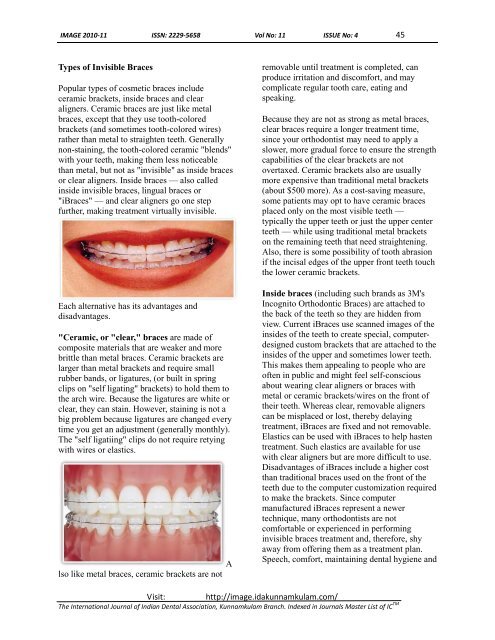'satisfactory smile' with a restorative approach - Indian Dental ...
'satisfactory smile' with a restorative approach - Indian Dental ...
'satisfactory smile' with a restorative approach - Indian Dental ...
You also want an ePaper? Increase the reach of your titles
YUMPU automatically turns print PDFs into web optimized ePapers that Google loves.
IMAGE 2010-11 ISSN: 2229-5658 Vol No: 11 ISSUE No: 4 45<br />
Types of Invisible Braces<br />
Popular types of cosmetic braces include<br />
ceramic brackets, inside braces and clear<br />
aligners. Ceramic braces are just like metal<br />
braces, except that they use tooth-colored<br />
brackets (and sometimes tooth-colored wires)<br />
rather than metal to straighten teeth. Generally<br />
non-staining, the tooth-colored ceramic "blends"<br />
<strong>with</strong> your teeth, making them less noticeable<br />
than metal, but not as "invisible" as inside braces<br />
or clear aligners. Inside braces ó also called<br />
inside invisible braces, lingual braces or<br />
"iBraces" ó and clear aligners go one step<br />
further, making treatment virtually invisible.<br />
Each alternative has its advantages and<br />
disadvantages.<br />
"Ceramic, or "clear," braces are made of<br />
composite materials that are weaker and more<br />
brittle than metal braces. Ceramic brackets are<br />
larger than metal brackets and require small<br />
rubber bands, or ligatures, (or built in spring<br />
clips on "self ligating" brackets) to hold them to<br />
the arch wire. Because the ligatures are white or<br />
clear, they can stain. However, staining is not a<br />
big problem because ligatures are changed every<br />
time you get an adjustment (generally monthly).<br />
The "self ligatiing" clips do not require retying<br />
<strong>with</strong> wires or elastics.<br />
A<br />
lso like metal braces, ceramic brackets are not<br />
removable until treatment is completed, can<br />
produce irritation and discomfort, and may<br />
complicate regular tooth care, eating and<br />
speaking.<br />
Because they are not as strong as metal braces,<br />
clear braces require a longer treatment time,<br />
since your orthodontist may need to apply a<br />
slower, more gradual force to ensure the strength<br />
capabilities of the clear brackets are not<br />
overtaxed. Ceramic brackets also are usually<br />
more expensive than traditional metal brackets<br />
(about $500 more). As a cost-saving measure,<br />
some patients may opt to have ceramic braces<br />
placed only on the most visible teeth ó<br />
typically the upper teeth or just the upper center<br />
teeth ó while using traditional metal brackets<br />
on the remaining teeth that need straightening.<br />
Also, there is some possibility of tooth abrasion<br />
if the incisal edges of the upper front teeth touch<br />
the lower ceramic brackets.<br />
Inside braces (including such brands as 3M's<br />
Incognito Orthodontic Braces) are attached to<br />
the back of the teeth so they are hidden from<br />
view. Current iBraces use scanned images of the<br />
insides of the teeth to create special, computerdesigned<br />
custom brackets that are attached to the<br />
insides of the upper and sometimes lower teeth.<br />
This makes them appealing to people who are<br />
often in public and might feel self-conscious<br />
about wearing clear aligners or braces <strong>with</strong><br />
metal or ceramic brackets/wires on the front of<br />
their teeth. Whereas clear, removable aligners<br />
can be misplaced or lost, thereby delaying<br />
treatment, iBraces are fixed and not removable.<br />
Elastics can be used <strong>with</strong> iBraces to help hasten<br />
treatment. Such elastics are available for use<br />
<strong>with</strong> clear aligners but are more difficult to use.<br />
Disadvantages of iBraces include a higher cost<br />
than traditional braces used on the front of the<br />
teeth due to the computer customization required<br />
to make the brackets. Since computer<br />
manufactured iBraces represent a newer<br />
technique, many orthodontists are not<br />
comfortable or experienced in performing<br />
invisible braces treatment and, therefore, shy<br />
away from offering them as a treatment plan.<br />
Speech, comfort, maintaining dental hygiene and<br />
Visit: http://image.idakunnamkulam.com/<br />
The International Journal of <strong>Indian</strong> <strong>Dental</strong> Association, Kunnamkulam Branch. Indexed in Journals Master List of IC TM



